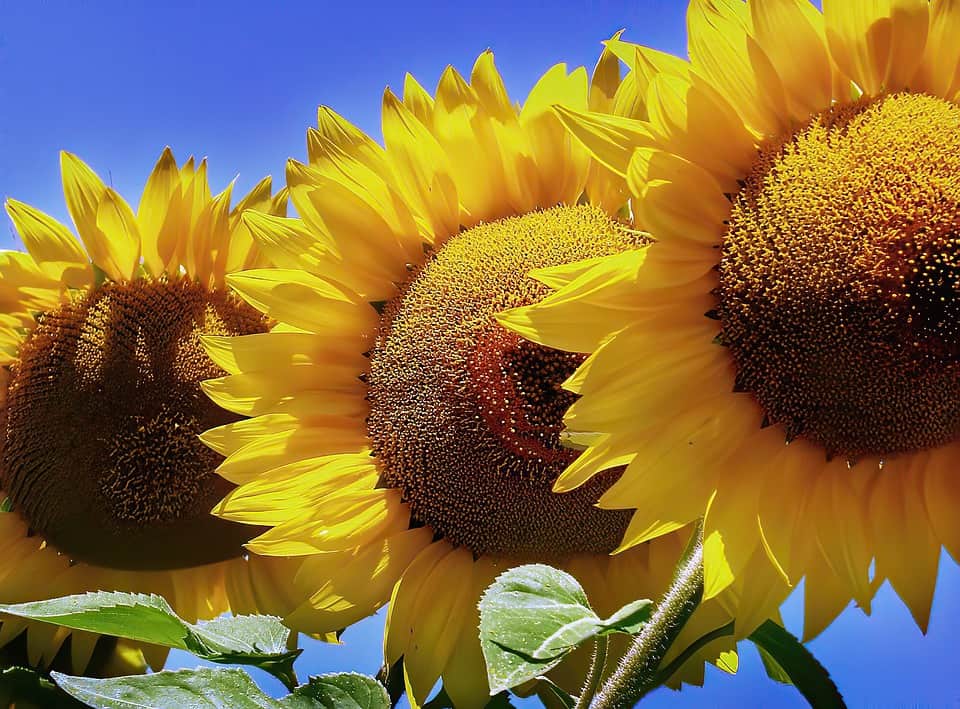Sunflowers are a favorite in the garden both for their beauty and the harvest of delicious, nutritious seeds. So, it can be disappointing to find some (or a lot) of your seeds are actually empty inside.
Poor seed filling (= the development and growth of the seed inside the shell) is not just a problem for home gardeners, but it’s a struggle for sunflower farmers as well, who want high yields for seeds or oil. There is still research being done on sunflower seed embryo development, but there are a few likely culprits responsible for empty sunflower seeds.
On this page:
1. Heat or drought stress after pollination
It’s well-known that too much heat or drought can lower yields in vegetables, and it’s no different for sunflowers. Heat waves or droughts can stress plants and reduce seed filling. [1] This process of seed development is complex and involves the production and movement of photosynthetic products as well as processes inside the seed itself.
If you had a stretch of very hot, dry days around the time your sunflowers were pollinated, it’s likely that this was a contributing factor to your empty seed shells.
While sunflowers that are direct sown have deep taproots, if you’re anticipating a heat wave, make sure your sunflowers are well watered. You can also use shade cloth to provide temporary protection, but for tall sunflowers this can be impractical.
2. Worm damage
If you notice a small hole in your empty sunflower seeds, it’s most likely a worm problem. Sunflowers are fairly resistant to pests, with the exception of a few species of insects. The most problematic ones lay eggs on the flower head and their larvae actually eat the developing seed inside.
The two main culprits are red sunflower weevils (Smicronyx fulvus) and gray sunflower weevils (Smicronyx sordidus). The first two will actually feed directly on the growing seed, then chew through the shell and drop to the ground, where they will find a place to overwinter, emerging as adults the following summer.
Unless you have significant worm damage, it’s often not worth the effort spraying sunflowers with organic insecticides (if you do, it’s best to apply when the flowers are just opening), as those same insecticides can kill beneficial pollinators and parasitic wasps, both of which contribute to boosting sunflower seed yields.

3. Phosphorus and/or nitrogen deficiency
Nutrient deficiencies can lead to more seed filling problems in sunflower seeds. Phosphorus is one of the key macronutrients for all plants, along with nitrogen and potassium, but is especially important for fruit and seed development. However, nitrogen also plays a key role as well, specifically related to seed filling. [2]
Nitrogen is more important for leaf and stem growth, however, seed filling is dependent on photosynthesis, and nitrogen ensures healthy leaves and metabolism in your sunflowers. Studies have shown that increasing nitrogen has a positive effect on sunflower yields, especially during the seed filling yield.
Feed sunflowers with balanced or high-nitrogen fertilizer early on while they’re focusing on leaf growth. Use a good slow-release fertilizer applied every month (or as per the instructions) or a gentle feeding of fast-acting liquid fertilizer every 7-14 days. As the sunflower plants reach their mature size, stay with a balanced fertilizer or switch to one with more phosphorus, such as “bloom” formula fertilizers.
4. A lack of solar energy (low light or defoliation)
So, nitrogen is important to give your sunflowers enough healthy leaves to drive photosynthesis, which is important for seed/kernel development. The next logical step would be to hypothesize that sunflowers with fewer leaves or leaves that are not getting enough sun would have more empty seeds.
It turns out several studies have examined the effect of defoliation (removing leaves) on sunflowers and found not only reduced yields, but also less seed filling, resulting in partially developed or even empty seeds. [3][4]
You likely won’t have to worry about your sunflowers being defoliated, but consider where you plant your sunflowers and how much sun they’re getting. For sunflowers, the more sun, the better. If you have rows of sunflowers or several planted close together, it’s possible that some may get shaded out, ending up with lower yields, and more empty seeds. For large sunflower varieties, spacing of around 3 feet (1 meter) apart is preferred, however you can plant them a bit closer and still get a good harvest. If planting a row, try to have them planted east to west, so they can all get adequate sunlight from the south. Avoid planting sunflowers next to north-facing fences or walls.
Sources:
[1] Sehgal, A.; Sita, K.; Siddique, K.H.M.; Kumar, R.; Oliver, M.J. (2018) Drought or/and heat-stress effects on seed filling in food crops: Impacts on functional biochemistry, seed yields, and nutritional quality. Front. Plant Sci. 2018, 9, 1705. https://doi.org/10.3389/fpls.2018.01705
[2] Nagarathna T. et al. (2016) Seed setting and productivity enhancement in sunflower (Helianthus annuus L.) by manipulating source and sink ratio using plant growth regulators, varying plant densities and nitrogen levels. International Conference on Plant Physiology & Pathology. June 09-10, 2016. P. 71-74. https://www.longdom.org/proceedings/seed-setting-and-productivity-enhancement-in-sunflower-helianthus-annuus-l-by-manipulating-source-and-sink-ratio-using-p-6484.html
[3] Grains Research & Development Corporation. (2017) Sunflower. Plant Growth and Physiology, GRDC Grownotes. 2017. https://grdc.com.au/__data/assets/pdf_file/0019/370612/GrowNote-Sunflower-North-04-Physiology.pdf [PDF]
[4] Aguirrezábal, L. A., Lavaud, Y., Dosio, G. A., Izquierdo, N. G., Andrade, F. H., and González, L. M. (2003). Intercepted solar radiation during seed filling determines sunflower weight per seed and oil concentration. Crop Sci. 43, 152–161. https://doi.org/10.2135/cropsci2003.1520
